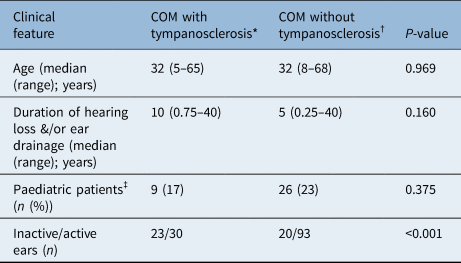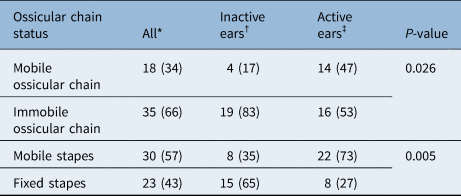Introduction
Chronic otitis media is the chronic inflammation of the middle-ear cleft and mastoid mucosa, in which the tympanic membrane is not intact and recurrent ear discharge or otorrhoea is present.Reference Verhoeff, van der Veen, Rovers, Sanders and Schilder1,Reference Bluestone2 Tympanosclerosis is a disorder that affects both the tympanic membrane and the middle-ear mucosa. The aetiology and pathogenesis of tympanosclerosis are still unclear, but the latter is a well-known sequela of acute and chronic otitis media.Reference Wielinga and Kerr3 Hearing loss in tympanosclerosis is due to fixed ossicles as a result of the calcification process, in addition to tympanic membrane perforation as found in chronic otitis media without tympanosclerosis.
Surgery is used to try and restore hearing in cases of tympanosclerosis. Some surgeons consider tympanosclerosis ‘the least amenable’ middle-ear disease for surgical treatment; others claim that, in experienced hands, surgical treatment of tympanosclerosis is a safe procedure, and that most patients have hearing results comparable to surgery performed for other chronic ear diseases.Reference Smyth4,Reference Giddings and House5 However, there is a disagreement about the best surgical procedure for this condition, with controversy regarding the management of tympanosclerosis when the stapes is involved.Reference Teufert and De La Cruz6 For this reason, knowledge regarding ossicular involvement in tympanosclerosis would permit better pre-operative counselling.
In the present study, we analysed the clinical characteristics of patients with chronic otitis media with tympanosclerosis and those of patients with chronic otitis media without tympanosclerosis. We aimed to investigate the value of pre-operative clinical evaluation in predicting the presence and severity (specifically regarding ossicular involvement) of tympanosclerosis.
Materials and methods
The study was approved by the ethics committee of Bülent Ecevit University. As the study was retrospective, patients’ informed consent was not obtained.
Patients
This institutional review board approved study was performed, retrospectively, on patients who underwent ear surgery for chronic otitis media with or without tympanosclerosis between March 2013 and June 2015. All patients exhibited otological symptoms such as recurrent otorrhoea or hearing loss. Diagnoses were made according to the patients’ history, otomicroscopy findings and audiometry results (obtained using a GSI 61 clinical audiometer; Grason-Stadler, Eden Prairie, Minnesota, USA). The diagnoses were confirmed intra-operatively. Ears with cholesteatoma or a tympanic membrane with retraction pockets, and revision cases, were excluded from the study.
Pre-operative findings
The investigated parameters of the clinical evaluation were: age, gender, disease duration (duration of the ear discharge and/or hearing loss), and ear activity in the year before surgery. ‘Active ears’ were those of patients with complaints of ear drainage and/or findings of inflamed middle-ear mucosa on otomicroscopy in the year prior to surgery. ‘Inactive ears’ were those that were dry for more than one year, or had never had discharge before.
Intra-operative findings
Ears were grouped according to the diagnoses of: chronic otitis media with tympanosclerosis, and chronic otitis media without tympanosclerosis. Ears with chronic otitis media involving at least one of the following areas were accepted as chronic otitis media with tympanosclerosis: malleolus handle, middle-ear mucosa, oval window, epitympanum (malleolus head, incus or incudomalleolar joint) or antrum mucosa.
The extension of the tympanosclerosis was determined according to the involvement of the ossicles. Ossicular mobility was recorded as: fixed or mobile stapes, and fixed or mobile incudomalleolar complex.
Study groups
The ears were allocated into two groups: chronic otitis media with tympanosclerosis, and chronic otitis media without tympanosclerosis.
In the chronic otitis media with tympanosclerosis group, the ears with fixation of the incudomalleolar complex and/or stapes were considered to have a fixed ossicular chain, and ears with both a mobile incudomalleolar complex and stapes were recruited into a mobile ossicular chain group. The ears with chronic otitis media with tympanosclerosis were also grouped according to whether they had a mobile or fixed stapes.
Ears were additionally categorised as active (draining ears in the year before surgery) or inactive (ears were dry for more than one year or no previous ear discharge).
Statistical analysis
Statistical analyses were performed with SPSS version 19.0 software (SPSS, Chicago, Illinois, USA). Data distribution was determined by the Shapiro–Wilk test. Continuous variables were expressed as mean ± standard deviation or median (range), and categorical variables were expressed as frequency and percentage. The Pearson chi-square test or Fisher's exact chi-square test was used to determine the difference between groups for categorical variables. Continuous variables were compared with the independent sample t-test or Mann–Whitney U test for two groups. A p-value of less than 0.05 was considered statistically significant for all tests.
Results
Clinical characteristics
The clinical characteristics of ears with chronic otitis media, with or without tympanosclerosis, were analysed (Table 1).
Table 1. Clinical features of ears with chronic otitis media, with and without tympanosclerosis

*n = 53; †n = 113. ‡Aged 18 years or younger. COM = chronic otitis media
A total of 166 ears were investigated: 53 ears (27 female, 26 male) with chronic otitis media with tympanosclerosis, and 113 ears (66 female, 47 male) with chronic otitis media without tympanosclerosis. In this series, tympanosclerosis was present in 32 per cent of the ears with chronic otitis media. Sixty-six per cent of ears in the chronic otitis media with tympanosclerosis group had ossicular chain fixation (a clinical significant finding).
The median age of patients was 32 years in both the chronic otitis media without tympanosclerosis group (range, 8–68 years) and the chronic otitis media with tympanosclerosis group (range, 5–65 years). The presence of disease was similar in paediatric (aged 18 years or younger) and adult patients: 26 of the 113 ears (23 per cent) in the chronic otitis media without tympanosclerosis group, and 9 of 53 ears (17 per cent) in the chronic otitis media with tympanosclerosis group belonged to paediatric patients.
According to the patients’ clinical history, the presence of middle-ear suppuration was significantly lower in the chronic otitis media with tympanosclerosis group, compared to the ears without tympanosclerosis.
Extension of tympanosclerosis
The relationship between the extension of tympanosclerosis and the patients’ clinical history was also analysed.
There was no significant difference in symptom duration among the ears with different ossicular chain status. Specifically, median symptom duration was: 10 years (range, 1–40 years) in ears with a fixed ossicular chain versus 9 years (range, 0.75–25 years) in those with a mobile ossicular chain (p = 0.924), and 10 years (range, 1–40 years) in ears with a fixed stapes versus 10 years (range, 0.75–30 years) in those with a mobile stapes (p = 0.637).
The activity of ears with chronic otitis media with tympanosclerosis was significantly different among the different ossicular chain status groups (Table 2). According to the clinical history, the rate of active ears was higher in ears with a mobile ossicular chain than in ears with an immobile ossicular chain (p = 0.026). The possibility of a mobile stapes in an ear with chronic otitis media with tympanosclerosis was higher in active ears compared to inactive ears (p = 0.005).
Table 2. Activity of ears with chronic otitis media with tympanosclerosis according to ossicular chain status

Data represent numbers (and percentages) of ears. *n = 53; †n = 23; ‡n = 30
Discussion
The incidence of the tympanosclerosis in ears with chronic middle-ear infection varies between 3 per cent and 43 per cent in the literature.Reference da Costa, Paparella, Schachern, Yoon and Kimberley7–Reference Emmet and Shea9 In the present series, tympanosclerosis was present in 32 per cent of the ears with chronic otitis media; 66 per cent of these ears had ossicular chain fixation (a clinically significant finding).
Knowing whether a patient with tympanosclerosis has a stapes fixation is important as this can have implications regarding the surgical results and potential complications. Additionally, stapes mobility is the most crucial factor to influence the hearing results. In one study, the best hearing results were found in patients with an intact ossicular chain and mobile stapes, and the poorest results were found in ears with a fixed stapes without suprastructure.Reference Lau and Tos10 Hearing results are better when the stapes is mobile and ossiculoplasty is performed with incus transposition.Reference Bayazit, Ozer, Kara, Gokpinar, Kanlikama and Mumbuç11 In ossicular attic fixation, ossicular reconstruction with a partial ossicular replacement prosthesis can give better results than the mobilisation of major ossicles in tympanosclerosis patients.Reference Teufert and De La Cruz6
We considered that some clinical evaluation parameters might be predictive of the ossicular chain status in tympanosclerosis cases. In our clinic, a patient's clinical history (i.e. duration of hearing loss and/or ear discharge, recent ear discharge) is determined by examining the history notes taken in their pre-operative visits. We record and archive consistent data on audiogram charts; we re-review inconsistent data with the patient and record confirmed data. The analyses in this study showed no differences in age or disease duration between ears with chronic otitis media with tympanosclerosis and those with chronic otitis media without tympanosclerosis. However, ears with tympanosclerosis were clinically characterised by the absence of middle-ear suppurations, usually for a long time. In addition, the probability of a mobile stapes (determined during surgery) was higher in ears with tympanosclerosis when there was ear drainage in the year prior to surgery.
These findings show that careful clinical history taking in tympanosclerosis cases can inform the surgeon about ossicular chain status, though the condition of the ossicular chain can only be determined during ear surgery. Anamnesis is always important in disease diagnosis, in addition to imaging and laboratory findings. We could not find any study on the predictive value of computed tomography for ossicular chain mobility. One study investigating the value of pre-operative audiometry reported that hearing loss in ears with an intact ossicular chain is frequency-dependent, and the hearing loss in ears with an immobile ossicular chain is more significant at lower frequencies, preserving better hearing at 2000 Hz.Reference Dinç, Damar, Erdem, Eliçora, Akyıldız and Kumbul12
Tympanosclerosis is characterised histologically by: decreased vascularisation and cell formation, increased hyalinisation, calcium deposition, and the formation of cartilage-like and/or bone-like tissue (secondary to increases in collagen fibrils due to progressive fibroblast infiltration of the connective tissue layer).Reference Sorensen and True13,Reference Ferlito14 The long-term absence of ear drainage may be due to widespread sclerosis of middle-ear mucosa. For this reason, the absence of ear drainage in the clinical history of a patient may indicate more extensive involvement of the ear by tympanosclerosis.
• There were no differences in age or disease duration between ears with chronic otitis media with or without tympanosclerosis
• Patients’ clinical history can inform of ossicular involvement in tympanosclerosis
• The probability of a mobile ossicular chain or mobile stapes is higher in ears with a clinical history of recent drainage in chronic otitis media with tympanosclerosis
• The long-term absence of ear discharge can indicate a fixed ossicular chain
In conclusion, tympanosclerosis is characterised by the long-term absence of ear drainage. The clinical history of a patient may reveal valuable information regarding ossicular involvement in tympanosclerosis. The probability of a mobile ossicular chain or a mobile stapes is higher in ears with a clinical history of recent drainage.
Conclusion
Chronic otitis media with tympanosclerosis is characterised by the long-term absence of suppurations. The probability of a fixed ossicular chain or stapes was higher in tympanosclerosis cases with no ear drainage.
Competing interests
None declared




